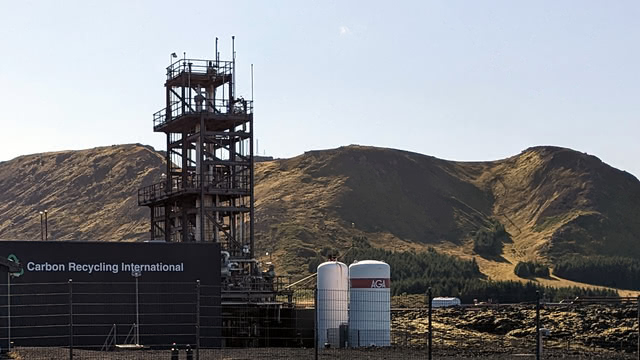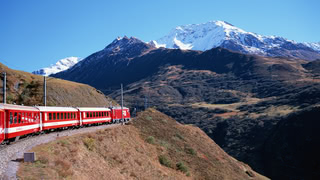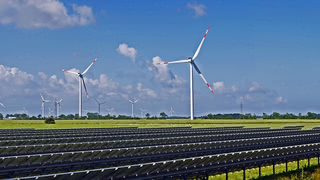Should we burn Methanol when the Wind does not blow?
Electricity grids with high shares of wind and solar energy will require energy storage over long periods of time. A new study suggests that green methanol might be more attractive than hydrogen in some cases.

Is methanol made with green electricity an overlooked option to store electricity for times with little wind and sun? A research paper published by two energy modelers in the scientific journal Joule suggests that combined with other technologies, methanol could outcompete hydrogen in certain situations.
Methanol is a liquid and today, its primary use is in the chemical industry. Existing methanol production usually relies on fossil gas or coal. But methanol can also be synthesized from hydrogen and carbon dioxide. If these processes are powered by renewable energy, they provide a path towards clean and low-carbon methanol production. Methanol can also be made from different types of biomass or waste.
Green Methanol for Shipping and Chemicals
Using such green methanol as a key element for a future clean energy system is not a new idea. Major players in the shipping industry, including the container shipping giand Maersk, consider green methanol as a future shipping fuel. Green methanol could help decarbonize the production of many petrochemical products, including plastics. (Covering overall green methanol use and ideas of a "methanol economy" is a topic for a future newsletter.)
Using methanol for electricity storage is not something that has been widely discussed yet. When electricity grids move to higher shares of wind and solar energy, there will be a need for technologies that balance the outputs of these energy sources. Flexible demands, grid improvements, and existing storage technologies can solve some of that, but storage over long timeframes is challenging.
Storage options like batteries or pumped hydro storage are very efficient and a good option to balance daily variations in energy generation. But they are not suitable to provide enough storage for days or weeks with little sun and wind – a situation often described with the German word "Dunkelflaute".
Tom Brown from the Technical University of Berlin and Johannes Hampp from the Potsdam Institute for Climate Impact Research (PIK) propose to have a closer look at methanol as a storage option. The idea combines two key technologies that already exist in pilot plants. It was first presented in a scientific paper published in 2019 (Baak et al, Energy Conversion and Management). Brown and Hampp have looked at how this storage concept would behave in an energy model over multiple years.
Combining Green Methanol with Oxyfuel Carbon Capture
The first key technology is the synthesis of methanol from carbon dioxide and hydrogen, often called e-methanol. Carbon Recycling International, a company based in Iceland, has been operating an e-methanol plant since 2011 in Grindavik. Energy and carbon dioxide are delivered from the Svartsengi geothermal power plant. Carbon Recycling International has since scaled up its technology. A much larger facility is operational in China, and another one – which I have previously mentioned in the context of plastics – is under construction.
The second key technology is an Allam Cycle turbine. It has been tested in a 50-megawatt power plant in La Porte, Texas, since 2018 by the company NET Power.
The Allam Cycle has a high energy efficiency, and it makes capturing carbon dioxide emissions easy. It burns fuel in pure oxygen instead of ambient air. The advantage of that is that the exhaust gases do not contain nitrogen, which avoids an expensive separation step if one wants to capture the carbon dioxide. Such technologies are known as oxyfuel. (I have discussed oxyfuel CCS technology before.)
Combining these two technologies allows to keep the carbon in a circular loop. The researchers call it carbon cycling. Methanol is made from green hydrogen and carbon dioxide. When electricity is scarce, methanol is burned in an Allam cycle turbine, the carbon dioxide is stored for future methanol synthesis.
There is an additional benefit to combining these technologies. Producing green hydrogen via electrolysis works by splitting water into its components, hydrogen and oxygen. The produced oxygen is usually not used and vented into the atmosphere, although in some cases electrolyzer operators are trying to sell it.
In the methanol storage scenario, oxygen is needed for the oxyfuel process. Using oxygen from electrolysis means less oxygen needs to be filtered from the air.
How does this method compare to other storage proposals? One commonly discussed method for ultra-long duration storage is using hydrogen, which can be burned in power plants not much different from today's gas plants.
Using hydrogen directly has the advantage that carbon dioxide is not involved, and it avoids an additional conversion step compared to methanol. So why even bother with methanol? The reason is that storing hydrogen comes with challenges.
Storing Methanol is easier than storing Hydrogen
Hydrogen can be stored in salt caverns, which has already been done in the oil and gas industry, and costs are relatively low. However, geological salt deposits are only available in certain regions, and some countries do not have them at all. Without salt caverns, one can use above-ground storage, which can happen in pressurized storage containers, underground storage in other formations, or transport electricity and hydrogen over long distances.
Pressurized storage containers have much higher costs, and underground storage in other formations has yet to be tested, and is expected to be more challenging. Industry studies also corroborate this: An analysis by German gas industry and gas storage associations associations concluded that all salt cavern storage facilities currently used for fossil gas can be repurposed for hydrogen. For storage facilities in porous rocks, they expect that only a fraction will be suitable for storing hydrogen.
An additional problem with hydrogen storage is that recent research has shown that hydrogen itself is an indirect greenhouse gas. Hydrogen impacts the breakdown of other greenhouse gases in the atmosphere. Therefore, if any hydrogen leaks, it contributes to climate change. A recent study expects that hydrogen in the atmosphere has around eleven times the warming effect of carbon dioxide. Any hydrogen infrastructure needs to ensure that little or no hydrogen escapes into the atmosphere.
Storing methanol, a liquid, is relatively easy and cheap in above-ground storage tanks that can be built anywhere. In an online event organized by Engineers Ireland (a YouTube recording is available), Brown said that twelve storage tanks, each taking up space of around 100 meters in diameter, could provide enough storage for a country like Ireland. There is an additional need to store carbon dioxide and oxygen. However, those gases are easier to store than hydrogen.
Methanol storage is so cheap that Brown and Hampp propose that it could also be used as inter-annual storage. The idea here is that wind and solar output does not only fluctuate daily and seasonally. The output also differs between years. Using a cheap storage option like methanol would allow for storing energy over multiple years and balancing out those fluctuations.
In their modeling, Brown and Hampp looked at how such a system would behave with weather data for three countries over a period of 71 years. They chose this long timeframe to incorporate inter-annual storage challenges. Around ten percent of the electricity would be provided by methanol. Grid interconnections between countries could lower that need further.
The model is based on the open source energy modelling software PyPSA, the researchers have also shared their assumptions and input data.
In terms of costs, hydrogen storage is still slightly cheaper than methanol if salt cavern storage is available. But compared to hydrogen storage in pressure vessels, methanol comes out much cheaper.
The researchers also incorporated a methanol-based storage scenario based on conventional gas turbines without carbon cycling. Interestingly, this has lower costs than the carbon cycling scenario with the Allam cycle turbines, although the difference is not huge. But it depends on the availability of direct air capture technology, which is in the early stages, or biogenic carbon dioxide sources, which will be needed by other industries as well.
Of course, such model calculations depend on many cost and efficiency assumptions that can change with technology development. The Allam cycle turbines have a major impact on the overall system cost. If they become cheaper, that route becomes more attractive. NET Power plans to have a larger power plant operational by 2026, although using fossil gas, not methanol. As Tom Brown told me, he had talked to NET Power, and they do not expect problems using methanol as a fuel.
Many of the technologies involved are currently undergoing heavy development. Hydrogen storage and other technologies along the hydrogen value chain are currently tested in multiple pilot projects. Green methanol technology has seen increased interest due to expected demand from shipping companies. A company called C1 is developing a methanol synthesis process with improved efficiency and plans to operate a pilot facility in Leuna, Germany, soon.
There is no clear-cut winner comparing these storage options, and it appears with salt cavern storage available, hydrogen would still be cheaper. But methanol has enough arguments in its favor that it should probably be considered as a serious contender for the future of electricity storage.
Author: Hanno Böck
Brief
-
Plenty of e-methanol projects have been announced or started lately. But this one is bigger than others: Chinese company Mingyang wants to begin construction of an e-methanol plant with a capacity of one million tons per year soon.
-
Researchers from the University of Wisconsin-Madison have published a pre-print looking into the possibility of developing a nationwide plastic recycling infrastructure for future chemical recycling in the US. One of the authors, Victor Zavala, summarizes the results on LinkedIn.
-
An analysis published by the Clean Air Task Force examined the costs of hydrogen long-distance transports. Conclusions include that hydrogen transport will likely stay expensive and that pipeline transport is usually cheaper than ship transport.
-
CCU or Power-to-X processes make it possible to create chemicals from hydrogen and carbon dioxide. How about using those technologies to make food with a lower carbon footprint? A paper published in Nature Sustainability proposes "Food without agriculture".



